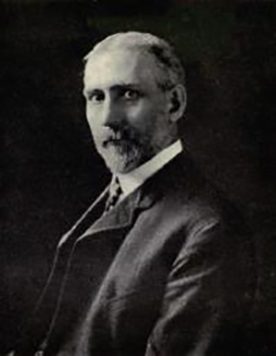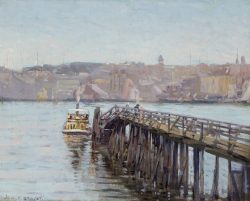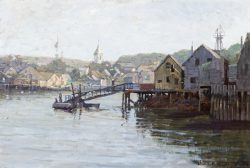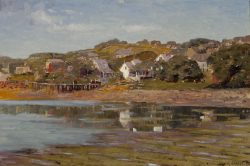John F. Stacey, from a photograph reproduced in Frances Cheney Bennett, History of Music and Art in Illinois (1904).

John F. Stacey 1859–1941
John Franklin Stacey was born in Biddeford, Maine, and received a practical art training at the Massachusetts Normal Art School in Boston. After serving as supervisor of drawing instruction in public schools in western Massachusetts, Stacey traveled to Paris in 1883 to study at the Académie Julian under prominent figure painters Gustave Boulanger and Jules Joseph Lefebvre. On his return to the U.S. three years later, Stacey became director of the Kansas City Art Association and School of Design. One of his pupils was Anna Lee Dey, whom he married in 1891. The couple moved to Chicago, where Stacey took a post as instructor in applied draftsmanship at R. T. Crane Manual High School. In 1894 he began a nearly four-decades-long career as a prolific exhibitor in the Art Institute of Chicago’s annual exhibitions.
Neither his academic art education nor his work as a teacher of applied draftsmanship prepared Stacey to make landscapes, yet from the start that was the exclusive focus of his work as a painter. Early in his career he found subjects in Wisconsin and Michigan as well as his native New England, particularly coastal Connecticut and Cape Ann, Massachusetts. Later, he also painted settings in Quebec, Belgium, France, Spain, California, Washington State, and the Catskill Mountains of New York. As early as 1900, with the Staceys’ visit to the art colony in Auvers-sur-Oise, France, he adopted impressionist methods of painting outdoors and of applying pigment in distinct, separated brushstrokes. In his traditional approach to composition and preference for pleasing rural settings, Stacey was a conservative painter. He enjoyed the favor of Chicago’s art public and mainstream reviewers, although he never quite achieved the professional renown that his wife enjoyed.
The Staceys shared a studio-residence in the Tree Studios building on Chicago’s Near North Side. Exhibiting nationally, John Stacey won several prestigious prizes, including three at the Art Institute and bronze medals at major expositions in St. Louis in 1904 and Buenos Aires in 1910. He served as president of the Chicago Society of Artists and later as vice president of the Association of Chicago Painters and Sculptors, a conservative group. The Staceys first visited California in 1915. When they retired to Pasadena in 1937, four years before John’s death, Chicago Tribune critic Eleanor Jewett observed that the Cliff Dwellers, the club of which he was a longtime member, would “miss Mr. Stacey with his robust arguments against modernism and his genial smile for everything else in the world.”i
Wendy Greenhouse, PhD
i Eleanor Jewett, “Chicago Loses Two Painters to California,” Chicago Tribune, Sept. 12, 1937.


